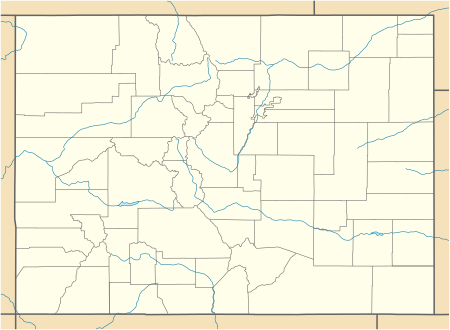Spanish Peaks
| Spanish Peaks | |
|---|---|
| Huajatolla | |
|
| |
| Highest point | |
| Elevation | 13,626 ft (4,153 m) |
| Coordinates | 37°23′N 105°00′W / 37.38°N 105°WCoordinates: 37°23′N 105°00′W / 37.38°N 105°W |
| Geography | |
 Spanish Peaks Map of Colorado | |
| Location | Huerfano County, Colorado |
| Designated | 1976 |
The Spanish Peaks are a pair of prominent mountains located in southwestern Huerfano County, Colorado. The Ute Indians named them Huajatolla (pronounced Wa-ha-toy-a), meaning "two breasts" or "breasts of the Earth".[1]
The two peaks, West Spanish Peak (13,626 feet or 4,153 meters) and East Spanish Peak (12,683 feet or 3,866 meters), are east of, and separate from, the Culebra Range of the Sangre de Cristo Mountains. West Spanish Peak is the second easternmost mountain over 4,000 meters in the United States, second only to Pikes Peak.
The Spanish Peaks were formed by two separate shallow (or hypabyssal) igneous intrusions during the Late-Oligocene epoch of the Paleogene Period.[2][3] West Spanish Peak is an older (24.59 +/- 0.13 Ma) quartz syenite. East Spanish Peak (23.36 +/- 0.18 Ma) is composed of a granodiorite porphyry surrounded by a more aerially-extensive exposure of granite porphyry. The granite porphyry represents the evolved upper portion of the magma chamber while the interior granodiorite porphyry is exposed by erosion at the summit.[4][5]
The Spanish Peaks were designated a National Natural Landmark in 1976 as one of the best known examples of igneous dikes.[6]
They were an important landmark on the Santa Fe Trail. The mountains can be seen as far north as Colorado Springs (102 miles (164 km)), as far west as Alamosa (85 miles (137 km)), points south to Raton, New Mexico (65 miles (105 km)), and points east of Trinidad (up to 15 miles (24 km)).
The Spanish Peaks Wilderness area of 17,855 acres (72.3 km2) encompasses the summits of both Spanish peaks. Hiking is popular in the wilderness area.
See also
References
- ↑ Evans, Frances P. (August 1958). "The Mystic Huajatolla". Trail and Timberline. Colorado Mountain Club: 103.
- ↑ Chronic, Halka (1998). Roadside Geology of Colorado. Mountain Press Publishing Company. p. 36. ISBN 0-87842-105-X.
- ↑ "Igneous Petrology of the Spanish Peaks". February 2012.
- ↑ Penn, B. S. (1994). An Investigation of the temporal and geochemical characteristics and petrogenetic origins of the Spanish Peaks intrusive rocks of south-central Colorado (Thesis). Colorado School of Mines. p. 199.
- ↑ Penn, B.S.; Lindsey, D.A. (2009). "40Ar/39Ar dates for the Spanish Peaks intrusions of south-central Colorado". Rocky Mountain Geology. 44 (1): 17–32. doi:10.2113/gsrocky.44.1.17.
- ↑ "National Registry of Natural Landmarks" (PDF). National Park Service. June 2009.
External links
| Wikimedia Commons has media related to Spanish Peaks. |
- Spanish Peaks @ Peakbagger
- National Park Service
